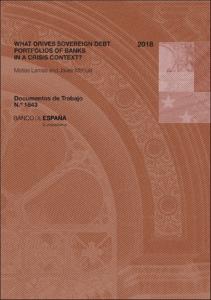What drives sovereign debt portfolios of banks in a crisis context?
Autor
Fecha de publicación
12-dic-2018
Descripción física
52 p.
Resumen
Estudiamos los determinantes de las tenencias de bonos soberanos de los bancos españoles sobre un período prolongado, que comienza en 2008. Nuestros resultados cuestionan la hipótesis de que los bancos decidieron sus estrategias de inversión en función de factores de riesgo moral, explotando el tratamiento regulatorio de las exposiciones soberanas. En concreto, mostramos que no hay relación entre un nivel bajo de capitalización bancaria y unas tenencias más elevadas de deuda soberana nacional. Aunque existe un fuerte vínculo entre el apoyo del banco central, a través de sus programas de liquidez, y las tenencias de deuda soberana, los comportamientos de tipo oportunista, o de búsqueda de rentabilidad, parecen limitarse a la cartera de deuda soberana extranjera de los bancos mejor capitalizados. Estos podrían haberse beneficiado de su mayor capacidad de absorción de riesgos para aumentar su exposición (vía liquidez del banco central) a los bonos soberanos más arriesgados. Por otro lado, también documentamos que la fragmentación financiera en los mercados de la zona del euro ha desempeñado un papel clave en la composición de las carteras soberanas. Nuestros resultados tienen implicaciones importantes para la discusión en curso sobre el diseño óptimo del tratamiento regulatorio de las exposiciones soberanas
We study determinants of sovereign portfolios of Spanish banks over a long time-span, starting in 2008. Our findings challenge the view that banks engaged in moral hazard strategies to exploit the regulatory treatment of sovereign exposures. In particular, we show that being a weakly capitalized bank is not related to higher holdings of domestic sovereign debt. While a strong link is present between central bank liquidity support and sovereign holdings, opportunistic strategies or reach-for-yield behavior appear to be limited to the non-domestic sovereign portfolio of well-capitalized banks, which might have taken advantage of their higher risk-bearing capacity to gain exposure (via central bank liquidity) to the set of riskier sovereign bonds. Furthermore, we document that financial fragmentation in EMU markets has played a key role in reshaping sovereign portfolios of banks. Overall, our results have important implications for the ongoing discussion on the optimal design of the risk-weighted capital framework of banks
We study determinants of sovereign portfolios of Spanish banks over a long time-span, starting in 2008. Our findings challenge the view that banks engaged in moral hazard strategies to exploit the regulatory treatment of sovereign exposures. In particular, we show that being a weakly capitalized bank is not related to higher holdings of domestic sovereign debt. While a strong link is present between central bank liquidity support and sovereign holdings, opportunistic strategies or reach-for-yield behavior appear to be limited to the non-domestic sovereign portfolio of well-capitalized banks, which might have taken advantage of their higher risk-bearing capacity to gain exposure (via central bank liquidity) to the set of riskier sovereign bonds. Furthermore, we document that financial fragmentation in EMU markets has played a key role in reshaping sovereign portfolios of banks. Overall, our results have important implications for the ongoing discussion on the optimal design of the risk-weighted capital framework of banks
Publicado en
Documentos de Trabajo / Banco de España, 1843
Materias
Tenencias bancarias de deuda soberana; Crisis soberana; Riesgo moral; Liquidez del banco central; Fragmentación financiera en la zona del euro; Banks’ sovereign holdings; Sovereign crisis; Moral hazard; Central bank liquidity; EMU financial fragmentation; Déficit y deuda públicos; Sistemas bancarios y actividad crediticia; Política monetaria; Instituciones crediticias de depósito; España; Zona euro
Aparece en las colecciones:












